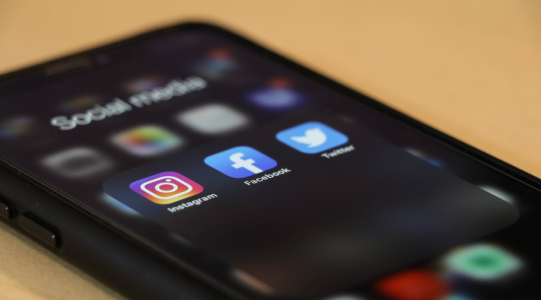Are you being watched online? This victim of cyberstalking shares shocking warning signs to look out for
In today's digital age, our lives seem online more than ever. We enthusiastically share updates, photos and personal information on social media and other platforms.
Unfortunately, with all these things available online, we can be susceptible to cyberstalking. A victim has recently shared her experience after being cyberstalked by her estranged husband.
For those wondering, cyberstalking refers to methodical and often persistent online harassment in the form of emails, texts and social media posts.
According to the eSafety Commissioner, it can start small—a person’s over-enthusiastic interest towards another or an invasion of privacy. At its worst, it can be accompanied by offline stalking and escalate into physical violence.
Cyberstalking can have devastating, life-changing consequences, and it’s important to be aware of the warning signs and to take the necessary steps to ensure our digital safety.
Jennifer, whose name has been changed to protect her identity, is a victim of cyberstalking. She decided to share her story to raise awareness and to help save others from the same fate.
Her nightmare began when she received strange notifications stating that her social media accounts were accessed from unrecognisable locations.
'I quickly made sure to block my stalker on social accounts and set them to private, as well as those close to him who may unknowingly feed information to him,' she said.
'It was frightening not to feel that I could communicate in the manner I typically do. I am now very aware of what information I share on the web to minimise my risk,' Jennifer added.
She mentioned that using privacy tools like blocking and minimising the information you share online is important.
The alarming fact that too few people know is that 67 per cent of cyberstalking victims know their stalker, according to U.S. Government research.
'Our digital and physical worlds are more intertwined than ever before. We are increasingly seeing the ramifications of online behaviour play out in real life, and the impacts from malicious actions can be devastating to victims,' said Keeper Security CEO and co-founder Darren Guccione.
Here are some warning signs to be aware of if you think you may be the victim of cyberstalking:
Password reset requests for your accounts that you didn’t initiate
If you received a password reset request you didn’t initiate, Guccione advised users to be suspicious.
‘This could be a sign that someone is trying to change your passwords to lock you out of your accounts and gain control of personal or financial information,’ Guccione said.
This could also happen in email accounts or banking accounts.
People pretending to be you on social media
This is a classic sign of cyberstalking. Abusers usually create fake profiles pretending to be their victims to spread misinformation or false stories to friends or family.
At its worst, they use it to harass the people in their victim’s life.
'If you believe a user has created new accounts for the purpose of harassing you, you can block those accounts too and report the user, as most websites have a policy against this behaviour,’ Guccione shared.
Sign-ons from unusual locations
As Jennifer mentioned, she realised she was being cyberstalked after seeing notifications saying her account had been logged into from strange places.
She recalled, ‘When I looked at where they were coming from, I discovered those logins were coming from the location of my estranged husband—sometimes from the home we used to share and sometimes from his work location.’
Unexplained packages arriving
If you didn’t purchase anything online but received a package, you need to be vigilant. Cyber-stalkers usually do this to demonstrate that they have their victims' information (like their home address) to strike fear.
People showing up to places you mentioned online
Guccione shared: ‘Online harassment and cyber-stalking do not always remain confined to the digital world.’
‘The lines can blur between cyber and physical stalking, and physical security must not be neglected. Using a Virtual Private Network (VPN) service and disabling geo-tagging on the digital photos you share online will ensure your true location is not traceable to an abuser,’ he added.
How to protect yourself against cyberstalkers
Aside from using VPN and disabling geo-tagging options on photos, Guccione also recommends minimising what you share online, taking advantage of privacy tools and using password managers.
‘A key component of cyberstalking is compromising the accounts and devices of victims to steal confidential information or install malware such as keyloggers to monitor their online activity and even track their physical location,’ he stated.

You can find more tips on their website here.
 What do you think of this story, members? Have you, or someone you know, experienced this? Share them in the comments below!
What do you think of this story, members? Have you, or someone you know, experienced this? Share them in the comments below!
Unfortunately, with all these things available online, we can be susceptible to cyberstalking. A victim has recently shared her experience after being cyberstalked by her estranged husband.
For those wondering, cyberstalking refers to methodical and often persistent online harassment in the form of emails, texts and social media posts.
According to the eSafety Commissioner, it can start small—a person’s over-enthusiastic interest towards another or an invasion of privacy. At its worst, it can be accompanied by offline stalking and escalate into physical violence.
Cyberstalking can have devastating, life-changing consequences, and it’s important to be aware of the warning signs and to take the necessary steps to ensure our digital safety.
Jennifer, whose name has been changed to protect her identity, is a victim of cyberstalking. She decided to share her story to raise awareness and to help save others from the same fate.
Her nightmare began when she received strange notifications stating that her social media accounts were accessed from unrecognisable locations.
'I quickly made sure to block my stalker on social accounts and set them to private, as well as those close to him who may unknowingly feed information to him,' she said.
'It was frightening not to feel that I could communicate in the manner I typically do. I am now very aware of what information I share on the web to minimise my risk,' Jennifer added.
She mentioned that using privacy tools like blocking and minimising the information you share online is important.
The alarming fact that too few people know is that 67 per cent of cyberstalking victims know their stalker, according to U.S. Government research.
'Our digital and physical worlds are more intertwined than ever before. We are increasingly seeing the ramifications of online behaviour play out in real life, and the impacts from malicious actions can be devastating to victims,' said Keeper Security CEO and co-founder Darren Guccione.
Here are some warning signs to be aware of if you think you may be the victim of cyberstalking:
Password reset requests for your accounts that you didn’t initiate
If you received a password reset request you didn’t initiate, Guccione advised users to be suspicious.
‘This could be a sign that someone is trying to change your passwords to lock you out of your accounts and gain control of personal or financial information,’ Guccione said.
This could also happen in email accounts or banking accounts.
People pretending to be you on social media
This is a classic sign of cyberstalking. Abusers usually create fake profiles pretending to be their victims to spread misinformation or false stories to friends or family.
At its worst, they use it to harass the people in their victim’s life.
'If you believe a user has created new accounts for the purpose of harassing you, you can block those accounts too and report the user, as most websites have a policy against this behaviour,’ Guccione shared.
Sign-ons from unusual locations
As Jennifer mentioned, she realised she was being cyberstalked after seeing notifications saying her account had been logged into from strange places.
She recalled, ‘When I looked at where they were coming from, I discovered those logins were coming from the location of my estranged husband—sometimes from the home we used to share and sometimes from his work location.’
Unexplained packages arriving
If you didn’t purchase anything online but received a package, you need to be vigilant. Cyber-stalkers usually do this to demonstrate that they have their victims' information (like their home address) to strike fear.
People showing up to places you mentioned online
Guccione shared: ‘Online harassment and cyber-stalking do not always remain confined to the digital world.’
‘The lines can blur between cyber and physical stalking, and physical security must not be neglected. Using a Virtual Private Network (VPN) service and disabling geo-tagging on the digital photos you share online will ensure your true location is not traceable to an abuser,’ he added.
How to protect yourself against cyberstalkers
Aside from using VPN and disabling geo-tagging options on photos, Guccione also recommends minimising what you share online, taking advantage of privacy tools and using password managers.
‘A key component of cyberstalking is compromising the accounts and devices of victims to steal confidential information or install malware such as keyloggers to monitor their online activity and even track their physical location,’ he stated.
Tip
If you feel unsafe, eSafety Australia advises online users to report any instances of cyberstalking to Triple Zero (000) or your local police through the police assistance line (131 444). Victims may also contact 1800RESPECT (1800 737 732) for advice and support.
You can find more tips on their website here.
Key Takeaways
- A woman has shared her experience of being cyberstalked by her estranged husband, highlighting warning signs and actions to protect oneself online.
- Signs of cyberstalking can include unexpected password reset requests, fake profiles impersonating the victim, and notifications of account access from unusual locations.
- US statistics reveal that 67 per cent of cyberstalking victims know their stalker.
- Digital security experts recommend minimising what one shares online, using tools like VPN apps to conceal location, using password managers, enabling two-factor authentication on important accounts, and disabling geo-tagging on digital photos.









